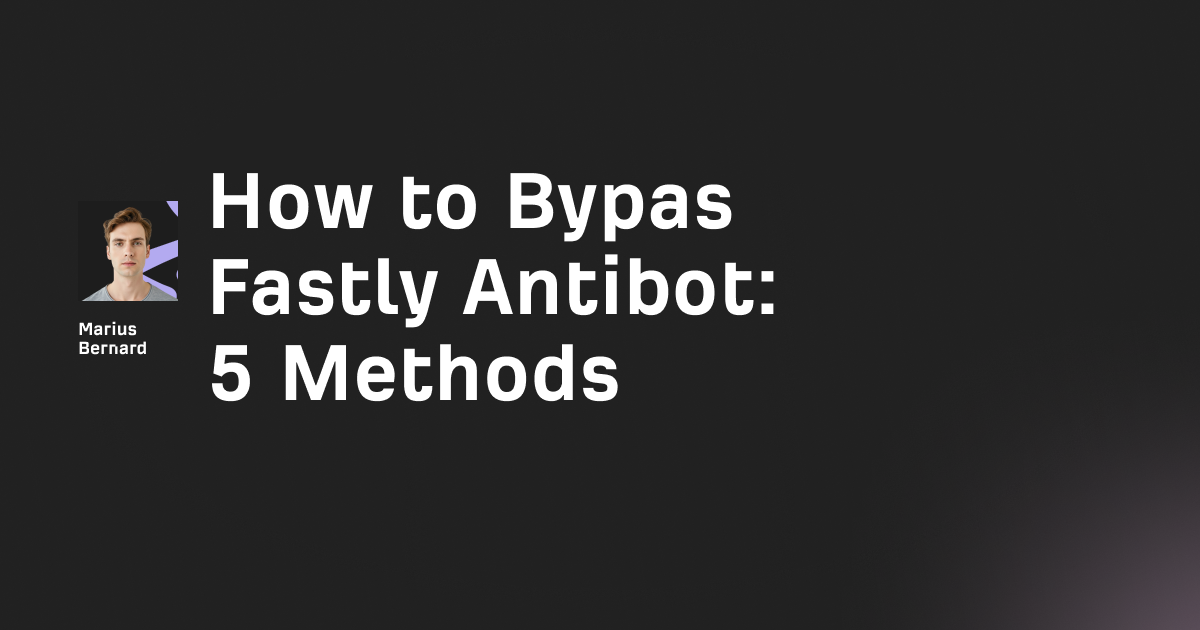Imperva Incapsula remains one of the most challenging bot protection systems for web scraping professionals. This cloud-based WAF service uses multi-layered detection to identify and block automated traffic.
For developers needing legitimate access to public data, understanding Incapsula's evolving protection mechanisms is essential.
This guide provides technically sound approaches to bypass Imperva Incapsula while emphasizing ethical scraping practices and compliance with website terms of service.
How Incapsula Detects and Blocks Bots: The Technical Foundation
Imperva Incapsula employs a sophisticated score-based detection system that analyzes hundreds of client characteristics across multiple layers.
Understanding these detection vectors is crucial before attempting any bypass strategy.
The protection establishes a unique trust score for each connecting client based on fingerprinting techniques, behavioral analysis, and reputation databases.
This multi-layered approach makes simple HTTP requests ineffective against protected targets.
TLS fingerprinting represents the first detection layer. Imperva analyzes the SSL/TLS handshake characteristics to create a JA3 or JA4 fingerprint that identifies client libraries.
Standard HTTP libraries like Python's requests reveal their automated nature through their encryption negotiation patterns, allowing detection before any application data is transmitted.
IP address reputation forms the second critical layer.
Imperva maintains extensive databases classifying IPs by type—datacenter, residential, or mobile.
Requests originating from known datacenter IPs (AWS, Google Cloud, Azure) receive lower trust scores and face immediate blocking.
HTTP protocol analysis examines your request characteristics.
Modern browsers predominantly use HTTP/2 or HTTP/3, while many scraping tools default to HTTP/1.1 . Header order, capitalization, and value authenticity are scrutinized, with missing Sec-CH-UA or Sec-Fetch-* headers signaling automation.
JavaScript execution provides the most potent fingerprinting capability.
Incapsula injects client-side scripts that probe browser APIs, canvas rendering, audio context, and hundreds of other properties.
These tests generate a unique browser fingerprint that headless environments struggle to replicate perfectly.
Behavioral analysis continuously monitors interaction patterns—mouse movements, request timing, navigation flow, and session duration.
Even well-configured scrapers can be detected through statistical analysis of these behavioral signatures over time.
Preparation: Analyzing the Target and Selecting Your Approach
Before writing any code, thoroughly analyze the specific Incapsula implementation on your target website. This reconnaissance informs your technical approach and identifies the minimal viable bypass strategy.
Identify protection markers through manual inspection.
Visit the target in a regular browser with developer tools open. Look for Incapsula indicators: _Incapsula_Resource scripts, visid_incap/incap_ses cookies, X-CDN headers with "Incapsula" values, or incident ID messages in block pages.
Document all observed endpoints, cookies, and challenge mechanisms.
Determine protection level by assessing which challenges trigger. Basic protection might only require proper headers and TLS configuration. Intermediate protection often involves JavaScript challenges.
Advanced implementations may deploy behavioral analysis with continuous monitoring. Understanding the protection tier helps avoid over-engineering your solution.
Check for alternative data sources before investing in complex bypass development.
Many websites offer public APIs or cached versions through Google Cache or the Wayback Machine . These sanctioned access methods eliminate bypass requirements entirely.
Select appropriate tools based on your protection analysis. For JavaScript-reliant protection, headless browsers with stealth patches are essential.
For API endpoints with simpler checks, optimized HTTP clients may suffice. Match your technical approach to the specific protection mechanisms you've identified.
Table: Incapsula Protection Levels and Corresponding Bypass Approaches
| Protection Level | Key Indicators | Recommended Approach |
|---|---|---|
| Basic | Simple cookie challenges, no JS dependencies | HTTP clients with proper headers/TLS |
| Intermediate | JavaScript challenges, fingerprinting | Headless browsers with stealth plugins |
| Advanced | Behavioral analysis, continuous monitoring | Distributed scraping with residential proxies |
Technical Bypass Methods: From Simple to Sophisticated
Headless browser automation represents the most accessible bypass approach for intermediate protection. Tools like Playwright, Puppeteer, and Selenium control real browsers that naturally pass many fingerprinting checks .
The critical enhancement involves stealth modifications that patch known automation detection points.
The puppeteer-extra-plugin-stealth addresses over 200 potential detection vectors, including navigator.webdriver property, extra permissions, and plugin patterns. For Playwright, similar functionality is emerging through community plugins.
Residential proxies effectively bypass IP-based blocking by routing traffic through legitimate ISP-assigned IP addresses.
Unlike datacenter proxies, these IPs have higher reputation scores and are less likely to trigger geographic or reputation-based blocking.
HTTP/2 protocol usage eliminates a major detection vector. Modern scraping libraries like curl_cffi or httpx with HTTP/2 support mimic browser protocol preferences.
This approach avoids the immediate suspicion associated with HTTP/1.1 connections from automated tools.
Header management goes beyond simply adding a User-Agent string.
You must replicate exact header order, capitalization, and values from real browsers . Include modern headers like Sec-CH-UA, Sec-Fetch-Dest, Sec-Fetch-Mode, and Sec-Fetch-Site with appropriate values for your navigation context.
TLS fingerprint randomization addresses the initial detection layer.
Specialized libraries can mimic browser TLS signatures, making your requests appear to originate from Chrome, Firefox, or Safari . The curl_cffi library implements this effectively for Python developers.
Behavioral distribution involves spreading requests across multiple IP addresses, user agents, and browser profiles . This approach prevents the accumulation of suspicious patterns that would trigger behavioral analysis blocks on individual sessions.
Implementation Guide: Code Examples and Configuration
Step 1: Headless Browser Implementation with Playwright Stealth
const { chromium } = require('playwright-extra');
const stealthPlugin = require('puppeteer-extra-plugin-stealth')();
playwrightExtra.use(stealthPlugin);
(async () => {
const browser = await chromium.launch({
headless: true,
args: ['--proxy-server=pr.oxylabs.go:7777']
});
const context = await browser.newContext({
viewport: { width: 1920, height: 1080 },
userAgent: 'Mozilla/5.0 (Windows NT 10.0; Win64; x64) AppleWebKit/537.36 (KHTML, like Gecko) Chrome/120.0.0.0 Safari/537.36'
});
const page = await context.newPage();
// Add random delays and movements
await page.waitForTimeout(2000 + Math.random() * 3000);
await page.mouse.move(100, 100);
await page.goto('https://target-protected-site.com');
// Handle potential Incapsula iframe challenges
const iframeHandle = await page.$('iframe#main-iframe');
if (iframeHandle) {
await page.waitForTimeout(3000);
await page.mouse.click(100, 100);
}
const content = await page.content();
console.log('Page content:', content);
await browser.close();
})();
This implementation combines stealth patching with realistic browser interactions. The random delays and mouse movements help defeat behavioral analysis while the proxy configuration prevents IP-based blocking .
Step 2: HTTP Client Approach with curl_cffi
from curl_cffi import requests
import json
def bypass_incapsula_http(url):
headers = {
'accept': 'text/html,application/xhtml+xml,application/xml;q=0.9,image/avif,image/webp,image/apng,*/*;q=0.8',
'accept-language': 'en-US,en;q=0.9',
'sec-ch-ua': '"Google Chrome";v="135", "Not-A.Brand";v="8", "Chromium";v="135"',
'sec-ch-ua-mobile': '?0',
'sec-ch-ua-platform': '"Windows"',
'sec-fetch-dest': 'document',
'sec-fetch-mode': 'navigate',
'sec-fetch-site': 'none',
'sec-fetch-user': '?1',
'upgrade-insecure-requests': '1',
'user-agent': 'Mozilla/5.0 (Windows NT 10.0; Win64; x64) AppleWebKit/537.36 (KHTML, like Gecko) Chrome/135.0.0.0 Safari/537.36'
}
# Using curl_cffi to impersonate Chrome TLS fingerprints
response = requests.get(
url,
headers=headers,
impersonate="chrome110",
proxy="http://user:pass@proxy:3128"
)
return response.text
# Usage
html_content = bypass_incapsula_http('https://protected-site.com')
This approach uses the curl_cffi library to mimic Chrome's TLS fingerprint while sending properly formatted headers.
It's significantly faster than browser automation for sites with simpler protection.
Step 3: Advanced Cookie Challenge Handling
import requests
from urllib.parse import unquote
def solve_incapsula_cookies(target_url):
session = requests.Session()
# Initial request to get challenge
initial_response = session.get(target_url)
# Extract Incapsula cookies from response
if 'incap_ses_' in initial_response.cookies:
print("Received Incapsula challenge cookies")
# Look for Incapsula resource script
if '_Incapsula_Resource' in initial_response.text:
# Extract the script URL for more advanced challenges
script_url = extract_script_url(initial_response.text)
# Execute the challenge script logic (simplified)
challenge_solution = solve_script_challenge(script_url)
# Make subsequent request with solution
session.headers.update({'X-Incapsula-Challenge': challenge_solution})
final_response = session.get(target_url)
return final_response
This simplified example demonstrates the cookie challenge handling process . Real implementations require parsing and executing JavaScript challenges, which may necessitate browser automation.
Step 4: Request Management with Rate Limiting
import time
import random
from requests.adapters import HTTPAdapter
from urllib3.util.retry import Retry
def create_resilient_session():
session = requests.Session()
# Configure retry strategy
retry_strategy = Retry(
total=3,
backoff_factor=0.5,
status_forcelist=[429, 500, 502, 503, 504],
)
adapter = HTTPAdapter(max_retries=retry_strategy)
session.mount("http://", adapter)
session.mount("https://", adapter)
return session
def respectful_scraping(urls, requests_per_minute=30):
session = create_resilient_session()
results = []
for url in urls:
# Respect rate limits
time.sleep(60 / requests_per_minute + random.uniform(0.1, 0.5))
try:
response = session.get(url)
if response.status_code == 200:
results.append(response.content)
elif response.status_code == 403:
# Implement specific Incapsula block handling
handle_incapsula_block(session, url)
except Exception as e:
print(f"Request failed: {e}")
return results
This implementation demonstrates respectful scraping practices with proper rate limiting and retry logic.
The random delay variations help avoid pattern detection.
Troubleshooting Common Issues and Blocks
403 Forbidden errors represent the most common Incapsula block manifestation.
These often indicate inadequate fingerprint protection or IP reputation issues. When encountering 403s, first verify your IP address quality, then check TLS fingerprint configuration, and finally review header authenticity.
CAPTCHA challenges signal that your requests are suspicious but not clearly automated . When facing CAPTCHAs, improve your behavioral patterns—add more human-like interactions, vary timing between actions, and ensure mouse movement simulation in headless browsers.
Incident ID blocks with messages containing "Request unsuccessful" and an incident ID indicate comprehensive detection.
These require fundamental approach changes—switch to higher-quality residential proxies, implement more advanced browser fingerprint masking, or distribute requests across more diverse infrastructure.
Session-based blocking occurs when initially successful access deteriorates over time.
This indicates behavioral analysis detection.
Implement session rotation—restart browsers or change fingerprints periodically rather than maintaining long-lived sessions.
Geographic blocking affects scrapers when target sites restrict access by region.
Ensure your proxy IPs originate from appropriate geographic locations matching your target audience profile.
Ethical Considerations and Compliance
Terms of Service compliance is the foundational ethical requirement. Always review and respect the target website's ToS and robots.txt directives.
Technical capability to bypass protection does not equate to legal authorization.
Rate limiting respect protects website infrastructure from excessive load. Implement polite scraping practices with conservative request rates, off-peak scheduling, and bandwidth throttling.
Monitor for performance impact indicators and adjust accordingly.
Data usage compliance ensures you only collect and use data within legal frameworks like GDPR, CCPA, and other applicable regulations.
Limit collection to publicly available information and implement proper data governance.
Ethical bypass justification requires legitimate purposes such as security research, competitive analysis of publicly available information, or integration where official APIs are unavailable.
Avoid scraping sensitive personal information, proprietary data, or content behind authentication walls.
Conclusion: Key Takeaways for Successful Implementation
Imperva Incapsula bypass requires a multi-layered approach addressing all detection vectors. Success depends on understanding the specific protection level implemented by your target and applying appropriate countermeasures.
Headless browsers with stealth patches effectively handle JavaScript challenges and fingerprinting for intermediate protection . Combine with residential proxies and behavioral variations for comprehensive coverage.
HTTP client approaches work for simpler protection when properly configured with HTTP/2, correct headers, and TLS fingerprint impersonation . These offer performance advantages for large-scale scraping operations.
Continuous adaptation is essential as Incapsula evolves detection methods . Monitor your success rates and be prepared to update approaches as new protection mechanisms emerge.
Ethical practices ensure long-term access while respecting website resources and legal boundaries . Prioritize official APIs when available and implement respectful scraping patterns even when technically capable of more aggressive approaches.
The techniques described provide legitimate paths for accessing public data protected by Imperva Incapsula. Implementation requires technical precision across multiple layers while maintaining ethical standards and legal compliance.








